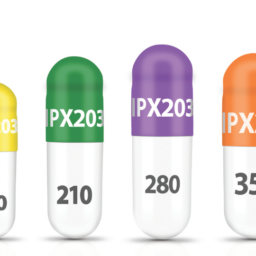Levodopa was first discovered in the early 1900s, but the first research connecting levodopa to Parkinson’s occurred in the 1950s when Swedish scientist Arvid Carlsson injected levodopa into rabbits that were exhibiting Parkinson’s symptoms. Within minutes, the rabbits’ symptoms disappeared.
When levodopa began to be tested in humans in the 1960s, it was viewed as a miracle drug, but the road to acceptance of levodopa as a viable Parkinson’s treatment was not smooth. In early human trials, side effects quickly became apparent, including dyskinesia and OFF periods. Moreover, levodopa’s tendency to produce nausea and vomiting was hard to overcome.
Still, following a successful two-year-long clinical trial in New York, the drug was approved for use in the United States in 1970, and since then, it has been the most widely used treatment for Parkinson’s. More about the history of levodopa is available in this 2010 article.
Available Formulations of Levodopa
Since the initial approval of levodopa over 50 years ago, multiple formulations have been developed, including:
Immediate-Release Carbidopa-Levodopa
This is now the form of levodopa most people take. This formulation pairs two medications: carbidopa and levodopa. Adding carbidopa helps levodopa cross the blood-brain barrier and helps limit nausea.
Immediate-release carbidopa-levodopa is available in multiple dosages with different ratios of the two medications. These dosages are:
- 10mg carbidopa/100mg levodopa
- 25mg carbidopa/100mg levodopa
- 25mg carbidopa/250mg levodopa
In some parts of the world, levodopa is paired with benserazide instead of carbidopa. The efficacy of these formulations is similar, but sometimes the available dosages may differ.
There are also two alternative oral formulations of immediate-release carbidopa-levodopa: Dhivy and Parcopa.
Dhivy
Dhivy is a segmented carbidopa-levodopa pill designed to allow incremental dosing.
Each Dhivy pill contains 25mg carbidopa and 100mg levodopa and features deep grooves that allow you to break the pill into different sizes easily. This allows you to adjust the amount of carbidopa and levodopa you take with each dose.
The Dhivy pill’s grooves allow you to break the pill into quarters such that the following dosages are available from each pill:
- ¼ Dhivy pill = 6.25mg carbidopa/25mg levodopa
- ½ Dhivy pill = 12.5mg carbidopa/50mg levodopa
- ¾ Dhivy pill = 18.75 mg carbidopa/75mg levodopa
- 1 Dhivy pill = 25mg carbidopa/100mg levodopa
Parcopa—Dissolving Capsules
Parcopa is a form of immediate-release carbidopa-levodopa that dissolves in your mouth. This form of carbidopa-levodopa is beneficial for people who have difficulties swallowing.
Parcopa is slightly faster acting than regular immediate-release carbidopa-levodopa. In clinical trials, the incidence of adverse events was similar between regular immediate-release formulation and Parcopa.
In some parts of the world, instead of Parcopa, a related formulation dissolves in a glass of water.
Extended- and Controlled-Release Formulations
Sinemet CR
Sinemet is a brand name for carbidopa-levodopa. Sinemet CR was the brand name for a “controlled release” formulation approved in 2011, and since 2019, this formulation has been available only as a generic medication.
A study comparing immediate-release carbidopa-levodopa to controlled-release carbidopa-levodopa found that a controlled-release dose reached maximum concentration in the body approximately 1.5 hours after ingestion. For most people, this is between 30 and 45 minutes slower than standard immediate-release carbidopa-levodopa. However, the study also found that controlled-released doses remained effective longer than immediate-release doses.
Because each controlled-release dose takes longer to have maximum effect, if you take this formulation, your doctor might recommend taking an immediate-release dose along with a controlled-release dose first thing in the morning.
Rytary
Rytary is a brand name for an extended-release formulation of carbidopa-levodopa. This formulation comes in capsules that contain beads of carbidopa-levodopa that are absorbed at different rates. Some beads are absorbed at the same rate as immediate-release carbidopa-levodopa, while others are absorbed more slowly. Studies have found that Rytary provides symptomatic relief for longer than immediate-release and controlled-release formulations, but more people report nausea as a side effect of Rytary than other formulations.
Another benefit of Rytary is that the capsules can be opened, and the medication beads can be distributed to help people with difficulties swallowing.
Rytary is available in multiple dosages, but it is important to know that the dosing is not directly comparable with other formulations of carbidopa-levodopa. If you switch from a different carbidopa-levodopa formulation to Rytary, the total amount of levodopa you take daily may change.
Stalevo
Stalevo is a brand name for another formulation of carbidopa-levodopa that is intended to extend how long each dose is effective. This formulation adds a third medication, entacapone, a COMT inhibitor that slows down the metabolism of levodopa.
Because entacapone slows levodopa metabolism, for most people, each Stalevo dose takes longer than immediate-release formulations and other extended-release formulations to reach maximum concentration in the body.
Stalevo is helpful for people experiencing troublesome ON-OFF motor fluctuations. Still, some studies have found that people taking Stalevo experience dyskinesia earlier than those taking only immediate-release formulations of carbidopa-levodopa.
Stalevo is available in multiple dosages, as shown in the table below.
| Carbidopa | Levodopa | Entacapone |
| 12.5mg | 50mg | 200mg |
| 18.75mg | 75mg | 200mg |
| 25mg | 100mg | 200mg |
| 31.25mg | 125mg | 200mg |
| 37.5mg | 175mg | 200mg |
| 50mg | 200mg | 200mg |
Duopa Pump
The Duopa Pump system supplies carbidopa-levodopa directly into the intestines via a pump. The Duopa Pump requires a surgical procedure during which a port is inserted into your abdomen. This port connects to a tube and an external pump that supplies carbidopa-levodopa according to a program you establish with your care team.
The Duopa Pump system reduces OFF periods. The Duopa Pump can also be especially helpful for people with swallowing difficulties or who might not be candidates for other advanced therapies like DBS.
Complications of the Duopa Pump system include:
- Surgical complications
- Tube displacement issues and/or port blockage
- Infection and inflammation
- The pump is usually disconnected at night, so many people still take immediate-release carbidopa-levodopa at night
- Wearing the pump can be uncomfortable or irritating
- Some studies have shown an increased incidence of depression among people who use the Duopa Pump.
Inbrija—Inhalation Powder
Inbrija is an inhaled formulation of levodopa that is used to treat OFF periods. In clinical trials, the medication led to improvements in motor symptoms in as little as ten minutes, and 58% of people taking Inbrija during an OFF period had returned to an ON state within sixty minutes. Inbrija can be used up to five times per day.
Data about absorption of the Inbrija does not support replacing oral carbidopa-levodopa with Inbrija. Although Inbrija takes effect faster, less levodopa enters circulation in the body when compared with oral carbidopa-levodopa.
Complications with Inbrija include cough and upper respiratory tract infections.
Levodopa Formulations in Trial
ND0612
ND0612 is the name for a new formulation of carbidopa-levodopa designed to be delivered by 24-hour subcutaneous injection. The method is similar to the infusion pumps used in treating diabetes.
In clinical trial, ND0612 was more effective than standard oral carbidopa-levodopa in both producing good ON time without dyskinesia and minimizing OFF time. Following of these positive results, the manufacturer plans to submit the drug for regulatory approval in the United States in 2023.
Accordion Pill
The accordion pill formulation aims to improve upon performance of other controlled release and extended release formulations of carbidopa-levodopa by altering the physical structure of the pill to extend the window of time the medication the pill contains can be absorbed in the body.
A phase three trial of this formulation failed to decrease OFF time, but because analysis of data from the trial showed that participants tolerated higher levels of levodopa when taking the Accordion Pill formulation than when taking standard oral carbidopa-levodopa, a new phase three trial is currently being planned.
The manufacturer of the accordion pill has also been investigating whether additional modifications to the pill structure can further extend the absorption window and produce even longer symptomatic improvements.
IPX203
IPX203 is a new extended-release formulation of carbidopa-levodopa that was submitted to the FDA for approval in November 2022.
In a phase-three clinical trial, IPX203 modestly improved daily ON time when compared to standard immediate-release carbidopa-levodopa which was taken an average of five times daily. Importantly, these improvements to ON time were achieved by taking only three doses of IPX203.
FDA Prescribing Information for Approved Formulations
Further Reading
How to Take Levodopa for Parkinson’s
Onset and duration of effect of extended-release carbidopa-levodopa in advanced Parkinson’s disease
Problems related to levodopa‐carbidopa intestinal gel treatment in advanced Parkinson’s disease
Should “on-demand” treatments for Parkinson’s disease OFF episodes be used earlier?
WANT MORE PRACTICAL ARTICLES LIKE THIS?
You can learn much more about living well with Parkinson’s today through our Every Victory Counts® suite of resources. Each manual is packed with up-to-date information about everything Parkinson’s. Click the link below to reserve your manual(s).
Thank you to our 2023 Peak Partners, Amneal, Kyowa Kirin, and Sunovion, and our Every Victory Counts Gold Sponsor, AbbVie Grants, for their ongoing support of these must-have manuals. Additionally, we’d like to thank Barbara and Dale Ankenman, Abby and Ken Dawkins, Bonnie Gibbons, Gail Gitin in loving memory of Gene Gitin, Irwin Narter, and Lorraine and J Wilson for their generous donations that allow us to make these resources available and free to all.

















